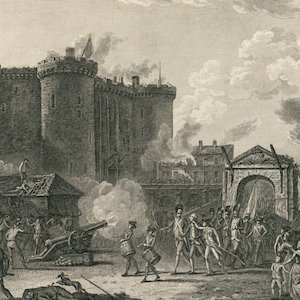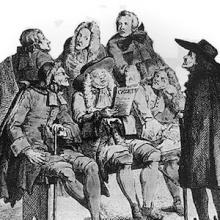Revolutions

Taking of the Bastille
The "bravery of the citizens united against" the royal army, as the text suggests, enabled them to conquer in four hours a fortress that had defeated invasions since 1368.

Taking of the Bastille
This painting emphasizes the populace’s participation in the storming of the Bastille, showing the urban population fighting under a red banner with muskets, swords, and pikes against the royal soldiers.

The Third Incident of 14 July 1789
This engraving from the Berthault series depicts Stanislas Maillard bravely climbing on a plank over the dry moat surrounding the fortress to accept from one of the soldiers Launay’s "capitulation" of the Bastille.

Analyzing Newspapers
The modules in Methods present case studies that demonstrate how scholars interpret different kinds of historical evidence in world history.

Taking of the Bastille
This color print emphasizes the populace’s participation in the storming of the Bastille, showing the urban population fighting under a red banner with muskets, swords, and pikes against the royal soldiers.

Taking of Weapons at the Invalides
From the City Hall, the crowd that had gathered on the morning of 14 July crossed the Seine River and sacked the royal veterans’ hospital known as the Invalides, where it hoped to capture arms. In Berthault’s engraving, the scene appears chaotic.

Speech in the Garden of the Palais-Royal
In this artistic rendition, on 12 July 1789 Camille Desmoulins stands on a table and encourages his listeners to rise against the threat to the Estates–General. He, and others of his ilk, would be successful in bringing about the fall of the Bastille on 14 July.

Fusillade in the Faubourg St. Antoine, 28 April 1789
This image chronicles a riot. Many believe it was caused by artisans who attacked the Reveillon wallpaper shop and factory because they believed that the owner was about to lower wages. Over two days, more than 6,000 attacked the place. On 28 April troops were called and fired on the crowd.

Fraternity
Using a woman to represent "Fraternity" seems ironic at best, although theoretically the term might mean the community of humanity. In actuality, when the revolutionaries considered "community," they certainly thought of men far more than women.

National Assembly Relinquishes All Privileges
This image, part of a series produced to show the most important events of the Revolution, focuses on 4 and 5 August 1789, when the system of privileges came to an end. This legal structure, characteristic of the old regime, guaranteed different rights for different people.